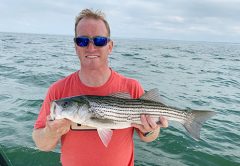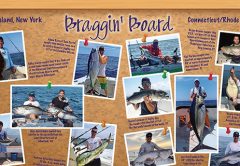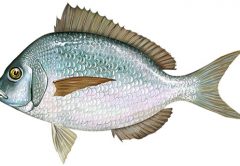Jeremy Way pointed his rod tip straight toward the water, tightened his line with a few cranks of the reel and lifted softly. As his rod took on a bend and a slight sensation of extra weight made itself evident, he transitioned smoothly to a sweeping hook-set that drove home his points. Immediately, the rod doubled over and began the aggravated dance salty Long Island bottom-fishing veterans unmistakably read as the signature of a hefty black sea bass.
“These fish are a lot of fun,” smiled Way as he tossed his fresh sea biscuits into the cooler and prepared to send his high-low rig back to the bottom. “They fight pretty well and I like that they are so willing to engage. Once you get the feel of how they bite, your hook-up ratio can be pretty high.”
Indeed, Way, had figured out at least two of the secrets to hooking these structure-loving treats – keeping a tight line and setting the hook with one smooth swing. Hailing from Malone, NY, just a few miles south of the Canadian border, he had never tried for sea bass before but by day’s end he was headed home to the North Woods with a pile of tasty fillets to dust with dry rub cHarissa seasoning and present as the featured guest at a family barbecue.
WILLING BUT WILEY
That a predominately freshwater angler from upstate New York could hold his own with the local Long Island crew aboard the Mattituck open boat, Capt. Bob, was really no surprise. Although Way took especially well to the task, black sea bass are willing combatants and a way to introduce anglers of all ages to the bottom-fishing game. While generally agreeable, they can show a marked preference for selected tides, may turn completely on or off at any point in time, and can even change how they take a bait from a gentle tap or slight sensation of added weight to an aggressive strike. In short, their temperament offers just enough challenge to be interesting while their size is enough to look impressive coming over the rail. That they taste so darn good is a sweet bonus.
piles, wrecks and humps covered with mussels that show a little “fuzz” on the fish-finder. If there is sufficient fuzz around – baitfish, shrimp, krill and other small fodder – the sea bass are likely to be nearby. Often, November blackfish hotspots are great sea bass honey holes in September and early October.”
One point to keep in mind when targeting sea bass is that their propensity to school tightly and feed aggressively means legal sized fish of 13 inches or more are sometimes culled quickly from popular spots. For this reason, it’s a good idea to head out with more than one spot to target in mind. Keep moving around if you aren’t catching, and explore areas near to larger pieces to see if you can find smaller chunks overlooked by the fleet. Fishing during midweek is another good idea if you have the flexibility.
“Black sea bass offer some challenge in that they move around both along the bottom and through the water column,” says Captain James Wolf of the Capt. Bob fleet. “It’s interesting also, how their bait preferences can change throughout the day. We almost always figure them eventually, but I think many anglers enjoy that the fishing is reliable without being mindless.”
Wolf’s simple summary hits the nail right on the head. On my trip with Way, for example, the sea bass held tight to heavy structure and showed a marked preference for small clam baits in the morning. Later in the day, they moved off the wrecks and wanted squid. Toward the end of the trip, the bite stalled – until Way put squid and clam together on the hook and ignited a steady bite along the starboard rail. Through the ups and downs, most anglers put away plenty of fillets for dinner – but those who made subtle adjustments as did the upstate angler tallied some extra meals to take home.
SEPTEMBER IS PRIME TIME
While anglers can catch sea bass throughout the summer and late into the winter months out most Long Island ports, September begins prime time for this species. From now through the fall months, you’ll find them inside bays, in Long Island Sound and out on sticky ocean bottom from 60 to 120 feet deep. Hopping on an open or charter boat is the surest way to join the fun, but private boaters do just fine anchoring over small patches of rough bottom or drifting along the edge of wrecks. The open boat fleet does especially well on this species out of Point Lookout, Freeport, Fire Island Inlet, Shinnecock and Moriches inlets, Montauk, Huntington, Port Jefferson, Mattituck, Greenport and Orient.
Of course, racking up a pile of sea bass fillets isn’t as simple as motoring out and dropping a line straight to the bottom. You need to do a little research first if heading out on your own. Look for high-profile rubble
THE TERMINAL END
While you can get away using spinning gear when working relatively shallow water for sea bass, conventional gear is a better choice as it offers more backbone and greater line control. For bay waters, choose a setup that can handle 12- to 20-pound test lines and 2- to 3-ounce sinkers. For ocean action, 20 to 30-pound test gear that can accommodate 5- to 8-ounce sinkers is ideal.
As far as the terminal end is concerned basic is best. Most anglers choose clam or strips of squid for bait. These are lowered to the bottom on a standard hi-low rig featuring a pair of size 1 to 3/0 beak baitholder style hooks. Get your line tothebottom,lockyourreelingear, and wait for the fun to begin. Some anglers opt for using three or even more hooks. I prefer to concentrate on a single bite or two and, with an eight-fish limit, I’ll usually tag out before the day is done. Because you’ll be working in rough bottom, be sure to check your hooks for sharpness throughout the day and watch especially for tiny mussels, pieces of sponge and even fish scales that can cover your hook points and prevent a solid set.
As the day progresses, be sure to note the small changes and shifts in action, and don’t hesitate to try something new. On a trip this August aboard Captain Ed Beneduci’s Montauk Star, the largest sea bass wanted only plain spearing. Another trip saw squid strips produce the majority of the catch. Recently, anglers adding a four-inch white Berkley Gulp! Swimming Minnow to their hooks have done particularly well – both with and without additional baits.
The best sea bass action I’ve seen this year, however, came when Way decided to combine a thin strip of squid with a small piece of clam on the same hook. Within a few drops to the bottom he was hauling CBs like a pro. That just goes to show that anyone with the willingness to try new things can stumble upon a hot ticket to September’s sea bass spectacular.
[easy-social-share]











